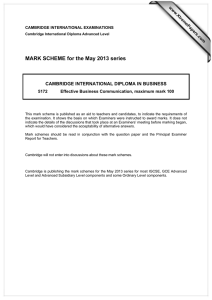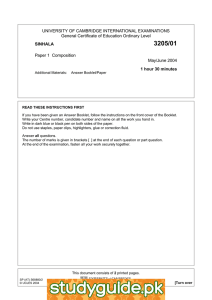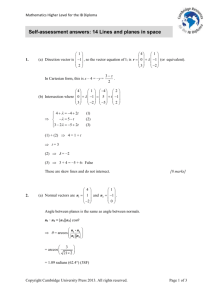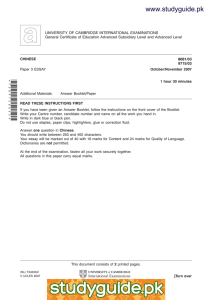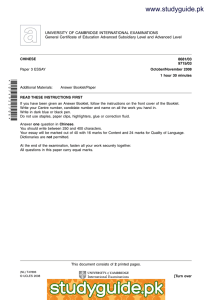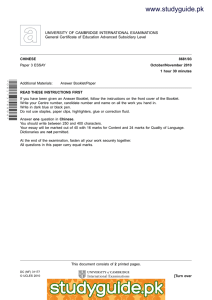MARK SCHEME for the October 2011 question paper
advertisement
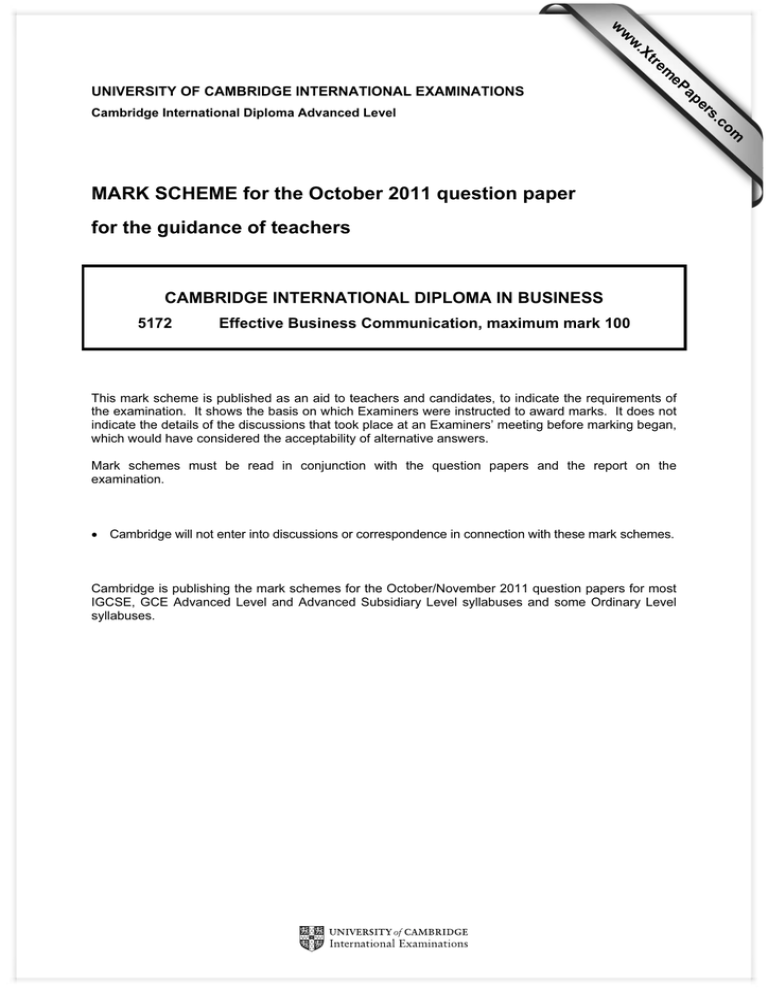
w w ap eP m e tr .X w UNIVERSITY OF CAMBRIDGE INTERNATIONAL EXAMINATIONS om .c s er Cambridge International Diploma Advanced Level MARK SCHEME for the October 2011 question paper for the guidance of teachers CAMBRIDGE INTERNATIONAL DIPLOMA IN BUSINESS 5172 Effective Business Communication, maximum mark 100 This mark scheme is published as an aid to teachers and candidates, to indicate the requirements of the examination. It shows the basis on which Examiners were instructed to award marks. It does not indicate the details of the discussions that took place at an Examiners’ meeting before marking began, which would have considered the acceptability of alternative answers. Mark schemes must be read in conjunction with the question papers and the report on the examination. • Cambridge will not enter into discussions or correspondence in connection with these mark schemes. Cambridge is publishing the mark schemes for the October/November 2011 question papers for most IGCSE, GCE Advanced Level and Advanced Subsidiary Level syllabuses and some Ordinary Level syllabuses. Page 2 1 Mark Scheme: Teachers’ version Cambridge International Diploma – October 2011 Syllabus 5172 Tao Chen is worried that there have been some internal problems which may have been caused because of poor communications. (a) Describe four two-way methods of communication which could be used within the company. [4 x 2 = 8] The main two-way methods are: Team Meetings Virtual Team Meetings Joint Consultations Quality Circles Seminars Briefings Telephone communications Telephone/video conferencing If the candidate lists methods 1 mark to be awarded. To be awarded 2 marks per method then an explanation of the two-way method must be given. (b) Identify four key causes of poor internal communications. No clear aim or purpose of communication established Use of inappropriate language Use of inappropriate medium Recipient unable to understand message due to understanding inappropriate [4 x 2 = 8] language/cultural No marks awarded for timings, distance and atmosphere. 2 marks to be given per cause. (c) Explain why a business needs to understand the communication process. [4] The role of business communications: external – communications with stakeholders including customers: internal – communications with different levels of employees as service providers, supervisors, managers in a range of situations such as change culture, crisis, takeover/merger situations. 4 marks can be awarded if candidate has identified both external and internal stakeholders. [Total: 20] © University of Cambridge International Examinations 2011 Page 3 2 Mark Scheme: Teachers’ version Cambridge International Diploma – October 2011 Syllabus 5172 (a) Write a letter to all employees inviting them to the Annual Employee Meeting. Confirmation of attendance will be required by 25 October 2011 for seating and buffet arrangements. Use the information in the case study and make up any other relevant details. [12] The letter should conform to the following format: Logo or letterhead of the company Date Reference number Address of Employee Appropriate salutation – Dear Mr/Mrs Letter heading The body / content of letter Explanation regarding the Annual Employee Meeting Enclosure of the Agenda Appropriate Closure – Yours sincerely Signature and position Response mechanism 6 marks for layout – logo, date, salutation, closure, signature and position, response mechanism. 6 marks for content – (1–3 marks) for basic information – meeting, date, enclosed agenda (4–6 marks) for good tone, persuasion to attend and full content – reply required and the importance of the meeting for all attendees regarding information. (b) Briefly explain to Tao Chen the benefits of the following types of communication which could be used with different customers and other stakeholders: (i) Electronic Mail [2] Saves time, paper, and money compared to the telephone or written letters Messages can be sent and received almost instantaneously The recipient may read the message anytime Allows you to communicate easily with many people at once Allows you to thoughtfully compose what you would like to say Keeps a semi-permanent record of the message (ii) Website [2] With an internet site, your product or service is accessible globally, to prospective customers 24 hours, 365 days a year. Websites are quicker, easier and more costeffective to update than print based media; therefore, you can have pictures, details and prices of your products, the very latest company information, or maps indicating the location of your company’s outlets on your website. A website can play an integral part of your promotional and marketing strategy. It also makes a powerful statement about your business, showing that you have planned for the future by securing your on-line presence today. (iii) Presentations Providing a follow-up question-and-answer session which: Allows evaluators face-to-face observation and interaction with key project members Improves depth of understanding behind the written proposal or presentation charts Permits better understanding of the overall approach to meeting the requirement © University of Cambridge International Examinations 2011 [2] Page 4 Mark Scheme: Teachers’ version Cambridge International Diploma – October 2011 Syllabus 5172 (iv) Press Releases [2] Can be placed in specialist magazines and publications. The information targets interested individuals or organisations. Used as a marketing tool to update readers. One-way communication only. [Total: 20] 3 As stated in the case study Synergy uses project teams to work on specific projects or tasks. (a) List six rules the project teams will use to ensure effective group communication. [6 x 1 = 6] Group attributes: recognised by its member and by those outside Norms: conform to patterns of outlook, attitude and behaviour Purpose: clearly stated objectives and aims Hierarchy: formal, or informal, leadership order Exclusivity: ability to grant or deny admission; loyalty of its members Sources of group conflicts: different obligations and responsibilities; inappropriate communication method; differing ideologies, beliefs. (b) Explain four factors which the project teams will need to consider to ensure that they are effective groups. [4 x 2 = 8] Factors affecting group effectiveness – structure, culture, mutual trust and support, consultation and involvement in decision-making. No marks awarded for size unless fully explained and related to case study. (c) List six characteristics of a successful meeting. [6 x 1 = 6] Aims and objectives Action points outlines Time constraint adhered to Leadership provided Role of key participants – chairperson, secretary, treasurer Agenda Minutes – written record of matters discussed with action points and decisions made [Total: 20] 4 You have been asked to take part as a member of an interview panel recruiting a new Marketing Manager. (a) Give a definition of a business interview. [2] Definition: a planned controlled communication between two or more people which enables both parties to speak and listen. © University of Cambridge International Examinations 2011 Page 5 Mark Scheme: Teachers’ version Cambridge International Diploma – October 2011 Syllabus 5172 (b) Explain what you, as the interviewer, will need to plan for this type of recruitment/ selection interview. [6 x 2 = 12] Consider type and purpose Who is going to be interviewed – short listing process Paper work – job description, person specification, applicant’s application form and letter of application Location and timing Preparation of questions – closed, open, leading, hypothetical Set criteria and structure the opening, body and close of the interview Recording mechanisms and the use of selection criteria for each interview to ensure unbiased decisions for recruitment interviews To contact interviewees with result (c) Open and closed questions can be used in an interview. Explain what open and closed questions are. Provide one example of each. [2 x 3 = 6] Open Question – although any question can receive a long answer, open questions deliberately seek longer answers, and are the opposite of closed questions: They ask the respondent to think and reflect They will give you opinions and feelings They pass control of the conversation to the respondent Closed Question – a closed question can be answered with either a single word or a short phrase. Thus 'How old are you?' and 'Where do you live?' are closed questions. A closed question can be answered with either 'yes' or 'no'. [Total: 20] © University of Cambridge International Examinations 2011 Page 6 5 Mark Scheme: Teachers’ version Cambridge International Diploma – October 2011 Syllabus 5172 The case study shows how Synergy operates though a hierarchical structure. (a) Describe how the features of a hierarchical organisation structure impact on the effectiveness of internal communications. [10] Level 1 (0–4 marks) The candidate may show a drawing of a hierarchical organisational chart and will have tried to explain the terms span of control and chain of command. Span of control: the number of people/subordinates that can be effectively managed by one person or the number of subordinates which are directly under their superiors. Chain of command: the order in which authority and power in an organisation is wielded and delegated from top management to every employee at every level of the organisation. Empowered: authorised and enabled to take decisions. Level 2 (5–7 marks) As for Level 1 but will include disadvantages regarding communication but clear opportunities for promotion. Level 3 (8–10 marks) A hierarchical structure has many layers of management, each with a narrow span of control. Instructions feed downwards from one level of management to those below. Feedback comes from the lower levels upwards. The reporting system from the top of the hierarchy to the bottom is known as the chain of command. A hierarchical structure enables tight control. It offers clear opportunities for promotion and may reduce stress levels in both managers and employees. Everybody knows their place in the hierarchy. However, communication can be a problem in hierarchical organisations. Without effective management, it can take a long time for information to pass up and down the chain of command. Staff may not be fully empowered. Rather than being able to use their initiative, employees may need to seek approval for every action from higher levels of managements. This not only can cause delay but also be bad for employee morale, reducing their motivation to work. (b) Tao Chen will be using charts, as part of his presentation to all staff, at the Annual Employee Meeting. Identify one advantage and one disadvantage of the following graphical charts. (i) Bar Chart [2] Advantages – bars have an individual identity either by name or with use of a key; possible use of three dimensions and colour to enhance visual impact. Disadvantages – limited visual impact if results are very close in value; limited number of bars per bar chart. (ii) Pie Chart [2] Advantages – use of colours to enhance impact of proportions of circle. Disadvantages – limited to the amount of in-depth information that can be conveyed using a pie or circle chart. © University of Cambridge International Examinations 2011 Page 7 Mark Scheme: Teachers’ version Cambridge International Diploma – October 2011 (iii) Line Graph Syllabus 5172 [2] Advantages – displays two sets of information and can be easily interpreted. Disadvantages – cannot readily or clearly interpret too many plotted lines of information. (c) List four multimedia facilities which Tao Chen could use to enhance his presentation. [4 x 1 = 4] Video, computer graphics, sound, overhead projectors and basic visual aids, PowerPoint as a means of presentation and production of high quality pre-prepared slides, graphics and animation. [Total: 20] © University of Cambridge International Examinations 2011
